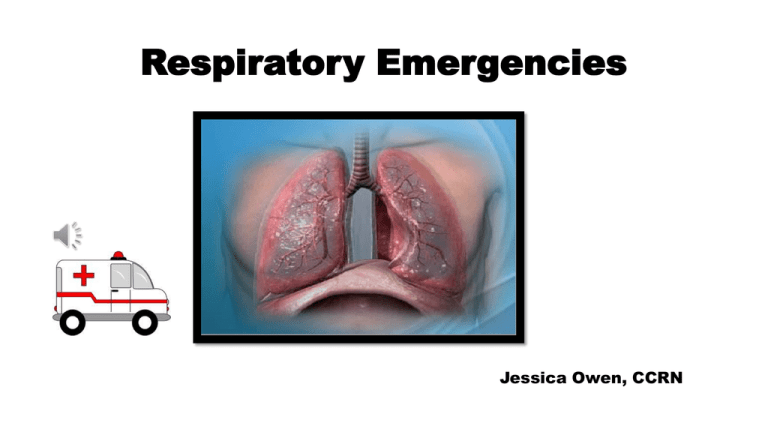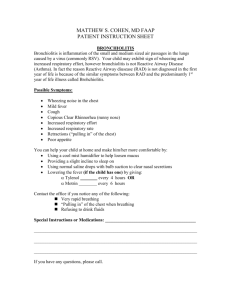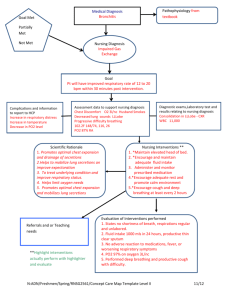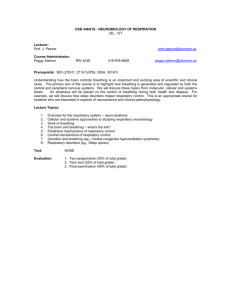File - Jessica Owen
advertisement

Respiratory Emergencies Jessica Owen, CCRN Anatomy Anatomy Physiology Inspiration Active process Chest cavity expands Intrathoracic pressure falls Air flows in until pressure equalizes Expiration Passive process Chest cavity size decreases Intrathoracic pressure rises Air flows out until pressure equalizes Physiology Developmental Variances of a Child’s Respiratory System Developmental Variances of a Child’s Respiratory System Adequate Breathing • Normal rate and depth • Regular breathing pattern. • Normal breath sounds on both sides of lungs. • Equal chest rise and fall. • Pink, warm, dry skin. Inadequate Breathing Breathing rate < 12 or > 20 Shallow or irregular respirations Unequal chest expansion Decreased or absent lung sounds Accessory muscle usage Pale or cyanotic skin color Cool, clammy skin appearance Pediatric Note Normal Respiratory Rates by Age Age Breaths/min Infant (< 1 year) 30 to 60 Toddler (1 to 3 years) 24 to 40 Preschooler (4 to 5 years) 22 to 34 School Age (6 to 12 years) 18 to 30 Adolescent (13 to 18 years) 12 to 16 Obstructive Pathophysiology • • • • • • Tongue Foreign body obstruction Anaphylaxis & Angioedema Facial trauma and inhalation injuries (burns) Epiglottitis and Croup Aspiration Restrictive Pathophysiology • Asthma • COPD Diffusion Pathophysiology • Pulmonary Edema: left-sided heart failure, toxic inhalations, near drowning • Pneumonia • Pulmonary Embolism: blood clots, amniotic fluid, fat embolism Ventilation Pathophysiology • Trauma: rib fractures, flail chest, spinal cord injuries • Pneumothorax & Hemothorax • Diaphragmatic hernia • Pleural effusion • Morbid obesity • Neurological/muscular diseases: polio, MD, myasthenia gravis Control System Pathophysiology • Head trauma • CVA • Depressant drug toxicity: narcotics, sedative-hypnotics, ethyl alcohol Acute Respiratory Failure OLD SCHOOL NEW SCHOOL Acute Respiratory Failure Old School Type I Hypocapnic Failure Decreased oxygen level with a normal or low CO₂ Ventilation – Perfusion Imbalance • • • • • Pulmonary Edema Pulmonary Embolism Aspiration Pneumonia Asthma ARDS Type II Hypercapnic Failure Decreased oxygen level with a high CO₂ level Respiratory Mechanical Performance • • • • • • • Drug Overdose COPD CVA Spinal Cord Injury MS: ALS, GB, MG Pneumothorax Hypophosphatemia Acute Respiratory Failure New School V/Q Mismatch Ventilation – Perfusion Imbalance • • • • • • COPD Asthma Atelectasis Pulmonary Edema Pulmonary Embolism Aspiration Pneumonia Shunt No Contact Between Blood and Alveoli • ARDS Initial Assessment Initial Impression: • Mental status • Respiratory rate and effort If not responsive and not breathing or no normal breathing GET HELP! With infants & children, if arrest is unwitnessed perform 2 minutes of CPR before leaving. • Pulse (rate & character) If no pulse start compressions and breaths (30:2) with 2 rescuers children & infant (15:2) If pulse but not breathing adequately, open the airway a perform rescue breathing. Rescue Breathing Rescue Breathing for Adults Rescue Breathing for Infants and Children • Give 1 breath every 5 to 6 seconds (about 10 to 12 breaths per minute). • Give 1 breath every 3 to 5 seconds (about 12 to 20 breaths per minute). • Give each breath in 1 second. • Each breath should result in visible chest rise. • Check pulse about every 2 minutes. Focused Assessment Signs and symptoms Allergies Medications Pertinent past medical history Last meal or intake Events leading to symptoms Focused Assessment Crackles (Rales) • CHF • Pneumonia Wheezing or Rhonchi • Pneumonia • Aspiration • COPD • Asthma Stridor • FBAO • Croup • Anaphylaxis • Epiglottitis • Airway burn Watch for critical signs: JVD, tracheal deviation, paradoxical chest movement. Plan • • • • • • • Help (?) – Rapid Response vs. Code Blue Put patient in position of comfort. Oxygen. Assist with medications. Calm and reassure. Minimize patient movement. Higher level of care. Golden Rules • If you are thinking about giving O2, then give it! • If you can’t tell whether a patient is breathing adequately, then they aren’t! • If you’re thinking about assisting a patient’s breathing, you probably should be! • When a patient quits fighting it does not mean that they are getting better! Case Study A 93 year old woman with dementia became cyanotic and apneic during Thanksgiving dinner at her family residence. The Heimlich maneuver was performed by family and the aspirated material was retrieved, which was recognized as two pieces of turkey. The patient had continued respiratory distress and was immediately brought to the emergency department, where her oxygen saturation was 93% on 10 liters/minute of oxygen via nasal cannula. A chest radiograph showed a collapsed left lower lobe, and emergency bronchoscopy removed two pieces of “food stuff” from the left main stem bronchus. She promptly recovered and was discharged two days later, with a swallowing study recommended as an outpatient. Foreign Body Airway Obstruction • Obstruction may result from head position, tongue, aspiration, or foreign body. • Be prepared to treat quickly and aggressively. • If you suspect a complete obstruction for a conscious victim, use manual technique appropriate for age. • < 1 year: Give 5 back slaps followed by 5 chest thrusts • >1 year: Give abdominal thrusts • If victim becomes unresponsive, start CPR, beginning with chest compressions (even if pulse is palpable. Before you deliver breaths, look into the mouth. If foreign body is visible and easily removable, remove it. • Do not perform a blind finger sweep! Case Study A 6-year-old male presents conscious, alert and oriented, sitting up in bed in a “sniffing” position and complaining of a sore throat. He has a strong and rapid radial pulse, and his respiratory rate is normal, but you note inspiratory stridor with each breath. His skin is warm and dry. His mother says he went to bed last night without any complaint but woke up this morning with a sore throat and fever. Since he awoke 5 hours ago, the patient’s fever has risen to 102.3ºF (39.0ºC), and the stridor developed. The mother reports the patient has no significant medical history and takes no medications. He has not received all of his vaccinations to date, as the parents are concerned about vaccine side-effects. She is not aware of any recent trauma or potential for foreign body ingestion. Airway Infections • • • • • • Epiglottitis Croup Ludwig’s angina Bronchiolitis Influenza Pneumonia Case Study A 38-year-old woman presented to the ED after visiting a relative in the hospital. She gave a 5-year history of recurrent conjunctival edema and rhinitis when blowing up balloons for her children's birthday parties. In the year prior to visit, three successive visits to her dentist triggered marked angioedema of her face on the side opposite to that requiring dental treatment. The swellings took 48 hours to subside. On the day of ED visit, she visited a critically ill relative in hospital. The patient was on reverse barrier precautions and visitors were required to wear gown and gloves. About 20 min after putting on the gloves her face and eyes became swollen, she felt wheezy and developed a pounding heart beat and lightheadedness. Her tongue started to swell. In the Emergency Department where she was given intramuscular epinephrine (adrenaline) and intravenous hydrocortisone. She recovered rapidly but was kept under observation overnight. Anaphylaxis • Characterized by respiratory distress (SOB, wheezes &/or stridor, hoarseness, pain with swallowing, cough); tachycardia or bradycardia; hives; swelling of tongue, lips, &/or mouth; and hypotension. • Usually results from body response to allergen (medications or additive, contact with natural rubber latex, contact with a solution, environmental, stings or bites). • Airway obstruction due to angiodema is major concern! • Follow Allergic reaction protocol. Case Study A 15 year old known asthmatic was admitted to the Emergency room after a week of progressive difficulty breathing. Her mother states that she had been sick with and upper respiratory infection and had been using her albuterol inhaler almost hourly until she ran out the day prior. On arrival she is alert, speaking in clipped sentences; sitting upright and appears very anxious. BP 150/90, HR 122, RR 32, O2 saturation 90% on room air. Over the course of her treatment in the ER she developed progressive hypoxia that was refractory to standard treatment requiring intubation. She was then transferred to the ICU and placed on continuous bronchodilator therapy through the ventilator. After two hours of continuous bronchodilator therapy there was dramatic improvement in her breath sounds. She continued to improve over the next 24 hours, and was extubated the next day. Status Asthmaticus • Severe asthma attack that doesn't respond to usual use of inhaled bronchodilators and is associated with symptoms of potential respiratory failure. • • • Signs & symptoms: • • • • • • • • Persistent SOB The inability to speak in full sentences Breathlessness at rest Chest tightness Cyanosis Agitation, confusion, or an inability to concentrate Hunched shoulders and accessory muscle use Tripod positioning • Beta-agonists and corticosteroids are mainstays in the treatment of status asthmaticus. Oxygen therapy is essential, with hypoxia being the leading cause of death in children with asthma. Indications for intubation & mechanical ventilation: • Apnea or respiratory arrest • Diminishing LOC • Impending respiratory failure marked by significantly rising PCO2 with fatigue & decreased air movement • Significant hypoxemia that is unresponsive to supplemental oxygen Case Study A 64-year-old female status post aortic valve replacement for severe aortic stenosis late on POD 2 suddenly experienced severe shortness of breath and began to cough up frothy pink sputum. The patient remained alert but became mildly confused, on auscultation exhibited end-inspiratory crackles throughout her lung bases, a pulse of 123 beats/min, a blood pressure of 121/73 mm Hg, and a respiratory rate of 28-32. Within 25 minutes of symptoms, she was intubated for ventilation, vigorous diuresis occurred and the patient's initially normal blood pressure plummeted to <70 mm Hg, systolic. At that point, the ECG also showed that the patient had developed atrial fibrillation (AF) with a rapid ventricular rate of 124 beats/min. The patient then received 150 mg IV Amiodarone over 10 minutes and was cardioverted at 120 J via a biphasic defibrillator into a NSR. Acute Pulmonary Edema • Signs & symptoms: • Paroxysmal nocturnal dyspnea • Frothy, pink sputum • Tachypnea • Tachycardia • JVD • Diaphoretic • Presence of a gallop • Crackles Case Study A 21-year-old female presented to the emergency department of a local hospital with a 6-week history of increasing muscle fatigue, dizziness and exhaustion. Prior to her arrival at the ER, her breathing became significantly more difficult, with the development of sharp chest pain. She denied cough, hemoptysis, wheeze, palpitations, or upper arm or lower leg pain or swelling. Just prior to the development of her initial symptoms she had taken a 3-hour flight home from a vacation. She was recently started on oral contraception, but denies smoking and is unsure about her families history of clotting disorders. A CT of her chest showed multiple pulmonary embolisms. She was started on SQ Lovenox and discharged home a few days later. Pulmonary Embolism • A blockage of the main artery of the lung or one of its branches by a substance that has travelled from elsewhere in the body through the bloodstream (embolism). • Signs & symptoms: • Dyspnea/tachypnea • Cyanosis • Acute pleuritic pain on inspiration • Hemoptysis • Hypoxia Case Study A 57-year-old male was admitted to the ICU after suffering a sudden cardiac arrest at home. His son provided 18 minutes of chest compression prior to EMS arriving and defibrillating the victim into a perfusing rhythm. The victim remained unresponsive, was intubated and cooling measures were instituted in the field. On arrival to the ICU he was tachycardic with frequent PVCs. An ABG revealed a PO2 of 60 and a CO2 of 56. Breath sounds were slightly decreased on the right side and peak inspiratory pressures on the ventilator were elevated. A stat portable chest X-ray revealed a tension pneumothorax on the right side. A chest tube was inserted on the right side with re-expansion of the lung and resolution of his symptoms. Tension Pneumothorax • Spontaneous or trauma induced • Accumulation of air in the pleural space • Signs & symptoms: • Dyspnea • One-sided chest pain • Absent or decreased breath sounds • Tachycardia • Tachypnea • Tracheal deviation away form affected side • Hyperresonant percussion note of the affected side • Reduced expansion and decreased movement of the affected side • Displacement of the apex beat • Resonant sound when tapping the sternum. Case Study A 20 year old male, brought to ER by ambulance crew with altered level of consciousness and respiratory depression. EMS states that the patient was found in a collapsed state by friend. The friend was unable to rouse patient and called 911. EMS inserted an OPA and started O2 @15 liters via BVM, in addition to administering Naloxone IM. On arrival to ER patient somnolent, ST at rate 120, BP 95/40, RR 8, O2 saturation 99%. Endotracheal intubated and fluid resuscitation commenced. Transferred to the ICU on mechanical ventilation and a Narcan drip. Less than 24 hours later patient was extubated and admitted to smoking heroin. Depressant Drug Toxicity Narcan is used to reverse opioid ingestion and serious opioid induce side effects. • Signs of opioid overdose: • Somnolent • Respiratory compromise (RR < 7, non-patent airway, low O2 saturation) • Pin point pupils Dilute 0.4mg Naloxone (1ml ampule) with 9ml NS in 10ml syringe (0.04 mg Narcan/ 1 ml) • Generally 0.04 mg administered IV over 30 seconds every 2-3 minutes until a change in alertness &/or respiratory depression is observed. Flumazenil is a benzodiazepine receptor antagonist. Treatment of overdose: • Initial dose: 0.2mg (2ml) given over 30 seconds, followed by 0.3mg (3ml) after 30 seconds. • Additional dose: 0.5mg (5ml) given over 30 seconds, every 1 minute to a maximum dose of 3mg total







